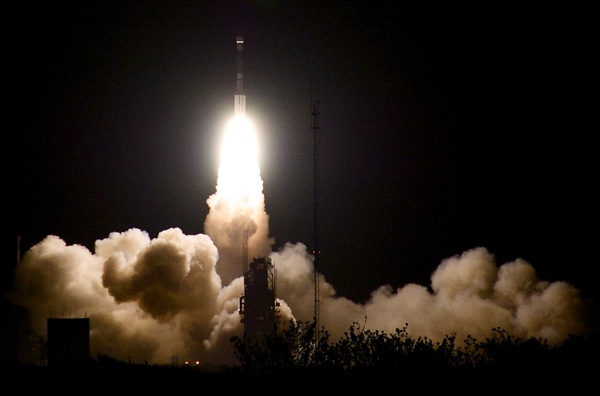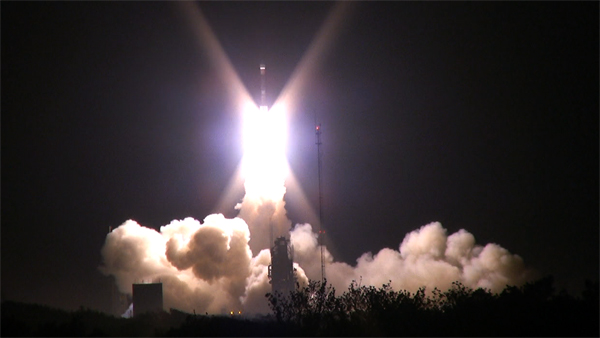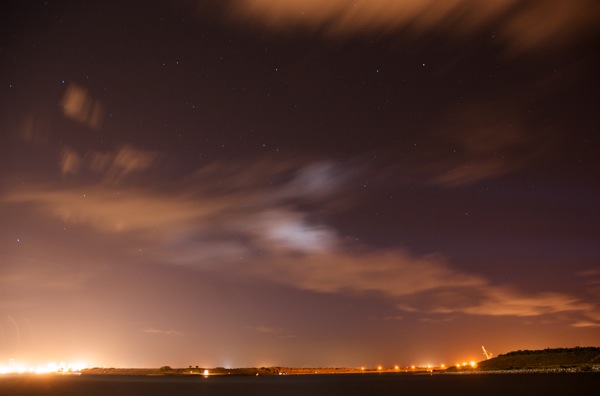
A Delta II rocket lifts off early Tuesday. I certainly could have stood to get more light into this photo.
Click on the "HD" button in the right corner (so it's red) to watch in high definition (again, I apologize for the jerkiness).
I set out for the beach early this morning to get a timed exposure of a Delta II rocket lifting off from Cape Canaveral.
I stopped in Cocoa Beach, near my old apartment, and walked onto the beach. This was the first night launch for which I haven't been at work, so to see the rocket bathed in giant spotlights was breathtaking. I was so captivated that I had to get closer. And getting closer would mean a timed exposure wouldn't be an option. My lens isn't wide enough to capture the whole sequence.
Jetty Park, near Port Canaveral, is 2.3 miles south of Launch Complex 17A at Cape Canaveral Air Force Station. It's the closest public viewing area for any launch. I decided I had to go there.
The gate for the park was closed, but a man at the entrance directed traffic through the outgoing lane. For a minute, I thought I wasn't going to get in. But I did, and unsurprisingly for a 4:34 a.m. launch, the place wasn't too crowded. Most people - including children, a Dutch couple and a man from Orlando who said he never misses a launch - complained that they were up too early. As for me, I was up too late.
On one side, the fishing pier at Jetty Park parallels the canal for ships making their way toward the port. On the other, it's a, well, jetty of large rocks. At the end of the pier, spectators had a clear view of the rocket as it sat on the pad. I found a table used for cleaning fish and started to set up my equipment.
I used only one segment of the tripod legs for my Nikon and plopped it onto the table. My video camera was set up beside the table with its tripod fully extended. I screwed my Pentax film camera to a 6-inch tripod and set it up atop the table.
I started recording video two minutes before liftoff. And within 30 seconds of the launch, I planned to lock the cable release of my Pentax to attempt a long exposure, then switch to my Nikon for some shots of the rocket lifting off the pad.
But for some reason, the cable release for the film camera wouldn't lock. And as I saw a glow coming from the pad at ignition, I abandoned the Pentax, which fell onto the table, and snapped away with the digital.
After several quick shots with the Nikon, I switched to my Canon high-definition video camera, attempting to track the rocket through it's flight. Doing that, however, was difficult with a tripod not really meant for video cameras. That's why you'll notice a lot of herky-jerky motions in the video.
In the first part of the video, you can hear my camera clicking away. When the clicking stops, that's when I take over the camera.
So I've got nothing to show from my film camera, and the digital shots came out slightly underexposed. I was worried sick about overexposure, which is what happened the first time I tried to shoot a nighttime shuttle launch.
Instead of quality, I went for quantity by trying to capture the launch in three media. It didn't work that well. In the future, I might have to set priorities.

This is just a frame grab from the video.

Contrails from the rocket blow in toward Port Canaveral (photo).



No comments:
Post a Comment